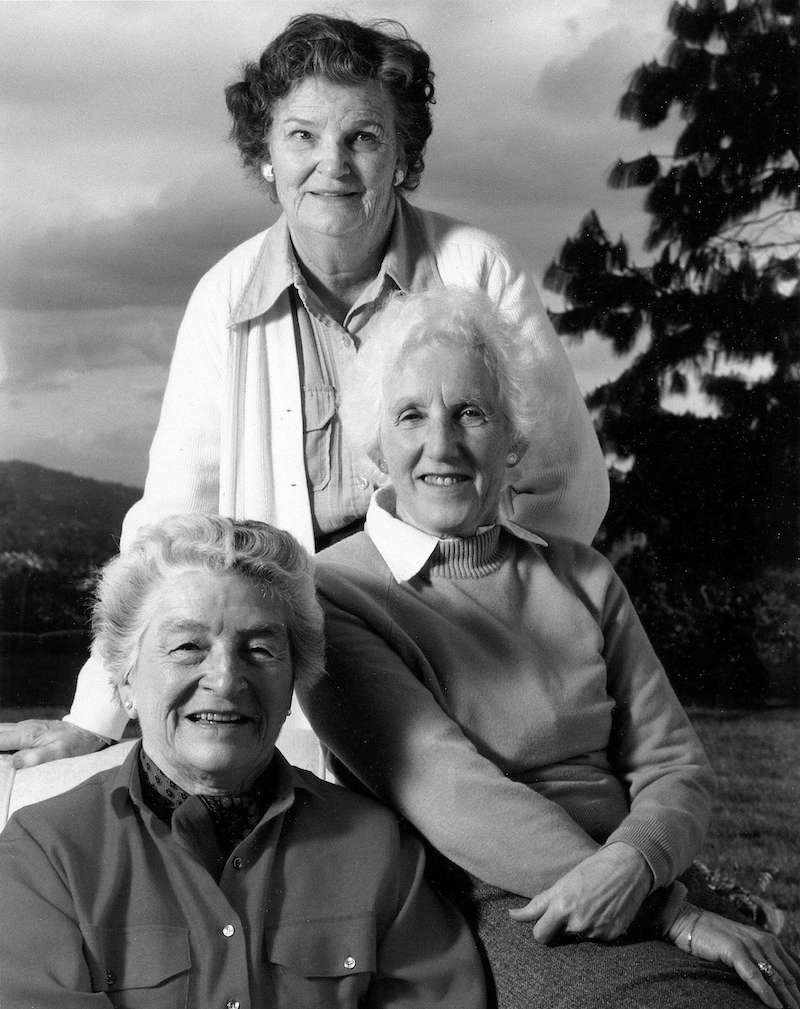
From top to bottom, Catherine Kerr, Esther Gulick and Sylvia McLaughlin in 2007
Recently OLLI members visited the Rosie the Riveter WWII Home Front National Historic Park in Richmond, CA. The park offers one of the most beautiful vistas of the San Francisco Bay. Joggers, bikers, and parents with babies in strollers following the Bay Trail passed by as we listened to OLLI member and Rosie docent Simone Adair provide us with an overview of the history of women and the bay. She deftly taught us not only about the women who helped build a record 747 warships to win WWII and save the world from fascism, but also the women who followed the shipbuilders into the history Hall of Fame by preventing the surrounding San Francisco Bay from being degraded with landfill. This is their story, the story of the women who saved the bay.
In 1961, Sylvia McLaughlin, Catherine (Kay) Kerr, and Esther Gulick became alarmed about the effects of dumping, sewage, and development on the San Francisco Bay. Ninety percent of the bay’s wetlands had been destroyed, the water was noxious, and there was virtually no public access to the shore. None of this was abstract to the three friends. From the vantage point of the East Bay hills, they could see trucks constantly offloading garbage into the bay. Galvanized by a city of Berkeley plan to double in size by filling in 2,000 acres of the bay, McLaughlin, Kerr, and Gulick decided to launch an organization to save the bay, eponymously known as Save the Bay. They leveraged their Christmas card lists, the UC Berkeley faculty directory, the membership rolls of churches and clubs to which they belonged, and the contact lists of organizations such as the Sierra Club, to send letters to 1,000 people, inviting them to join Save the Bay at only one dollar apiece. To their surprise, McLaughlin, Kerr, and Gulick received 900 membership pledges, a number that eventually grew to tens of thousands.
To make their case to the city of Berkeley, McLaughlin, Kerr, and Gulick visited all the city council members, flooded each one with mail, and spoke at every public meeting held by the city. They backed their arguments with the names of the vast Save the Bay membership, in addition to research and commentary provided by economists, lawyers, city planners, and biologists whom they consulted. While Pete Seeger was moved to compose a song of support, developers criticized and blocked McLaughlin, Kerr, and Gulick. Others dismissed and mocked them as naïve housewives. Yet, within the brief span of two years, the trio succeeded in persuading Berkeley to abandon its massive bay fill plan. What’s more, their vision for the bay captured the imagination of neighboring cities. Regional support emboldened McLaughlin, Kerr, and Gulick to advocate for state action to save the bay. In 1965, their lobbying efforts resulted in the birth of the world’s first coastal management agency — The Bay Conservation and Development Commission — made possible by the enactment of the McAteer-Petris Act.
Sixty years later, the San Francisco Bay is encircled by a 350-mile-long trail connecting 47 cites. The trail is the hallmark of the return to public ownership of privately-owned shore land and its transformation into walking and cycling paths, parks, and wetlands. The living legacy of McLaughlin, Kerr, and Gulick is additionally embodied by a statewide coastal protection agency, local and state funding to protect the health of the bay, environmental education programs for schoolchildren, and strategic efforts to mitigate sea level rise and other manifestations of climate change.
Margaret Mead once said, “never doubt that a small group of thoughtful, committed citizens can change the world.” Her words are an apt description of Sylvia McLaughlin, Kay Kerr, and Emily Gulick.
Linda Wing, Ph.D., is an OLLI @Berkeley member and volunteer who spent more than 45 years working to transform public schools in order to enable students in the nation’s cities to learn and achieve at high levels. Wing is a regular contributor to the OLLI Blog.